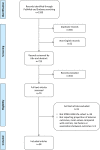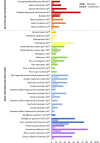Multidisciplinary and neuroimaging findings in preterm born very low birthweight individuals from birth to 28 years of age: A systematic review of a Norwegian prospective cohort study
- PMID: 35867340
- PMCID: PMC9542186
- DOI: 10.1111/ppe.12890
Multidisciplinary and neuroimaging findings in preterm born very low birthweight individuals from birth to 28 years of age: A systematic review of a Norwegian prospective cohort study
Abstract
Background: Children born preterm with very low birthweight (VLBW) face long-lasting neurodevelopmental challenges, where multidisciplinary assessments are warranted. The International Classification of Functioning, Disability and Health (ICF) provides a framework for understanding and conceptualising these outcomes.
Objectives: We aimed to review clinical and neuroimaging findings from birth to adulthood in a Norwegian cohort of individuals born preterm with VLBW (gestational age <37 weeks, birthweight ≤1500 g) within the framework of ICF.
Data sources: We searched PubMed and Embase for articles reporting results of the Norwegian University of Science and Technology (NTNU) Low Birth Weight in a Lifetime Perspective study.
Study selection and data extraction: We included original articles reporting proportions of adverse outcomes, mean group differences, risk factors or associations between outcomes. Data were extracted according to ICF's two-level classification. Body functions and structures comprised outcomes of brain structures, cognition, mental health, vision, pain and physical health. Activities and participation comprised motor skills, general and social functioning, education, employment, and health-related quality of life.
Synthesis: We performed a qualitative synthesis of included articles. Where mean (SD) was reported, we calculated group differences in SD units.
Results: Fifty-eight publications were included. Within body functions and structures, increased prevalence of brain structure pathology, lower cognitive performance, mental health problems, visual and physical health impairments through childhood, adolescence and young adulthood were reported among preterm VLBW participants compared with controls. Within activities and participation, motor problems, lower general and social functioning, and lower academic attainment were found. Perinatal factors were associated with several outcomes, and longitudinal findings suggested persistent consequences of being born preterm with VLBW.
Conclusions: Being born preterm with VLBW has long-term influences on body functions and structures, activities and participation. The ICF is appropriate for assessing general domains of functioning and guiding the management of individuals born preterm with VLBW.
Keywords: cognition; magnetic resonance imaging; mental health; motor skills; social functioning; very low birthweight.
© 2022 The Authors. Paediatric and Perinatal Epidemiology published by John Wiley & Sons Ltd.
Figures



References
-
- Sullivan MC, Lynch E, Msall ME. Late adolescent & young adult functioning and participation outcomes after prematurity. Semin Fetal Neonatal Med. 2020;25:101118. - PubMed
-
- Aarnoudse‐Moens CSH, Weisglas‐Kuperus N, van Goudoever JB, Oosterlaan J. Meta‐analysis of neurobehavioral outcomes in very preterm and/or very low birth weight children. Pediatrics. 2009;124:717‐728. - PubMed
-
- Pyhälä R, Wolford E, Kautiainen H, et al. Self‐reported mental health problems among adults born preterm: a meta‐analysis. Pediatrics. 2017;139:e20162690. - PubMed
Publication types
MeSH terms
LinkOut - more resources
Full Text Sources

